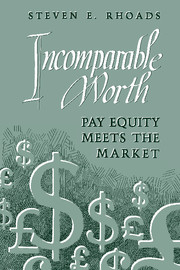Book contents
- Frontmatter
- Contents
- Acknowledgments
- 1 Introduction
- 2 The debate over equal pay for comparable worth
- 3 Implementing comparable worth in Minnesota
- 4 Job evaluation in Minnesota localities
- 5 Equal pay for work of equal value in the European Community
- 6 Equal pay for work of equal value in the United Kingdom
- 7 Equal pay for work of equal value in Australia
- 8 Conclusion
- Appendix: a note on the research and presentation of findings
- Notes
- Index
1 - Introduction
Published online by Cambridge University Press: 06 July 2010
- Frontmatter
- Contents
- Acknowledgments
- 1 Introduction
- 2 The debate over equal pay for comparable worth
- 3 Implementing comparable worth in Minnesota
- 4 Job evaluation in Minnesota localities
- 5 Equal pay for work of equal value in the European Community
- 6 Equal pay for work of equal value in the United Kingdom
- 7 Equal pay for work of equal value in Australia
- 8 Conclusion
- Appendix: a note on the research and presentation of findings
- Notes
- Index
Summary
The comparable-worth movement gets its fuel from a number – $.71. This is the amount that women working full time in 1990 earned for every dollar earned by men working full time. Supporters of comparable worth believe that at least half of the wage gap reflects discrimination and that women in many predominantly female occupations are paid substantially less than their work is actually worth. Comparable worth would require employers to pay employees equal salaries for dissimilar jobs requiring “comparable” amounts of factors such as know-how, problem solving, accountability, and undesirable working conditions. The Hay Associates job evaluation system, for example, used these four factors to rate delivery van drivers and “clerk typists 2” working for the state of Minnesota. The jobs were found to be of equal worth, but the maximum monthly salary for the delivery van driver was more than $200 higher. Under Minnesota's 1982 pay-equity law this disparity was remedied by means of a substantial raise for clerk typists.
Sometimes comparable worth is seen as a way to eliminate racial discrimination in pay, but it is everywhere aimed at eliminating gender discrimination in pay. The women's movement as well as some unions with large numbers of women members have kept the issue alive in the public arena. Their goal is a substantial reduction in the female–male wage gap.
The effort to establish equal pay for comparable worth is worldwide, though in most of the world it goes by the title “equal pay for work of equal value.” For over fifteen years, Australia and the countries of the European Community (EC) have legally required both public and private employers to base salaries on comparable-worth/equal-value criteria.
- Type
- Chapter
- Information
- Incomparable WorthPay Equity Meets the Market, pp. 1 - 6Publisher: Cambridge University PressPrint publication year: 1993



